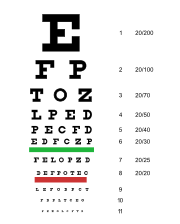
Hermann Snellen
Encyclopedia


Snellen chart
A Snellen chart is an eye chart used by eye care professionals and others to measure visual acuity. Snellen charts are named after the Dutch ophthalmologist Herman Snellen who developed the chart during 1862...
to study visual acuity
Visual acuity
Visual acuity is acuteness or clearness of vision, which is dependent on the sharpness of the retinal focus within the eye and the sensitivity of the interpretative faculty of the brain....
(1862). He took over directorship of the Netherlands Hospital for Eye Patients after Dr. Franciscus Donders
Franciscus Donders
-External links:* B. Theunissen. , F.C. Donders: turning refracting into science, @ History of science and scholarship in the Netherlands.* in the Virtual Laboratory of the Max Planck Institute for the History of Science* P. Eling, , Geneeskundige en fysioloog....
.
Biography
Snellen was born in ZeistZeist
Zeist is a municipality and a town in the central Netherlands, located east of the city of Utrecht.-Population centres :*Austerlitz*Bosch en Duin*Den Dolder*Huis ter Heide*Zeist- The town of Zeist :...
, Netherlands
Netherlands
The Netherlands is a constituent country of the Kingdom of the Netherlands, located mainly in North-West Europe and with several islands in the Caribbean. Mainland Netherlands borders the North Sea to the north and west, Belgium to the south, and Germany to the east, and shares maritime borders...
.
He studied medicine at Utrecht University
Utrecht University
Utrecht University is a university in Utrecht, Netherlands. It is one of the oldest universities in the Netherlands and one of the largest in Europe. Established March 26, 1636, it had an enrollment of 29,082 students in 2008, and employed 8,614 faculty and staff, 570 of which are full professors....
under Franciscus Donders
Franciscus Donders
-External links:* B. Theunissen. , F.C. Donders: turning refracting into science, @ History of science and scholarship in the Netherlands.* in the Virtual Laboratory of the Max Planck Institute for the History of Science* P. Eling, , Geneeskundige en fysioloog....
, Gerardus Johannes Mulder
Gerardus Johannes Mulder
Gerardus Johannes Mulder was a Dutch organic and analytical chemist-Biography:Mulder was born in Utrecht, and earned a medical degree from Utrecht University....
and Jacobus Schroeder van der Kolk
Jacobus Schroeder van der Kolk
Jacobus Ludovicus Conradus Schroeder van der Kolk was a Dutch anatomist and physiologist, and an influential researcher into the causes of epilepsy and mental illness....
, earning his medical degree in 1858. He specialized in ophthalmology, working as an assistant physician at the Netherlands Hospital for Eye Patients (Nederlandsch Gasthuis voor Ooglijders) after completing his degree. He was named to succeed Donders as the institute's director in 1884, a position he served in until 1903. In 1877 he was appointed as a professor of ophthalmology at Utrecht University. He did research on astigmatism
Astigmatism
An optical system with astigmatism is one where rays that propagate in two perpendicular planes have different foci. If an optical system with astigmatism is used to form an image of a cross, the vertical and horizontal lines will be in sharp focus at two different distances...
, glaucoma
Glaucoma
Glaucoma is an eye disorder in which the optic nerve suffers damage, permanently damaging vision in the affected eye and progressing to complete blindness if untreated. It is often, but not always, associated with increased pressure of the fluid in the eye...
and other eye diseases, as well as research on correction of visual acuity using eyeglasses and ophthalmological surgery.
While other versions had been developed before him by Eduard Jäger von Jaxtthal
Eduard Jäger von Jaxtthal
Eduard Jäger von Jaxtthal was an Austrian ophthalmologist who was a native of Vienna. He was a professor at the University of Vienna, and was son to oculist Friedrich Jäger von Jaxtthal , and grandson to Georg Joseph Beer .Jäger is remembered for his work involving eye operations, and his research...
and others, Snellen developed his eponymous eye chart in 1862 to measure visual acuity, which rapidly become a global standard. The most significant innovation was his use of what he called optotype
Optotype
An optotype is a standardized symbol for testing vision. Optotypes can be specially shaped letters, numbers, or geometric symbols. For instance, to determine visual acuity, optotypes of different sizes are presented to a person and the smallest size is determined at which the person can reliably...
s, specially designed characters generated on a 5x5 grid, rather than using standard fonts. They provide a physical standard measure that could be used when printing the chart. Standard vision was measured as the ability to correctly read a line of optotype characters when they subtended 5 minutes of arc and were separated by 1 minute of arc.
Since its inception, more copies of the Snellen Chart have been sold in the United States than any other poster. It has remained a ubiquitous standard in medical offices into the 21st century.

